
The Jin dynasty, officially known as the Great Jin, was an imperial dynasty of China that existed between 1115 and 1234. Because the Wanyan clan that founded the dynasty were of Jurchen descent, it is also sometimes called the Jurchen dynasty or the Jurchen Jin.
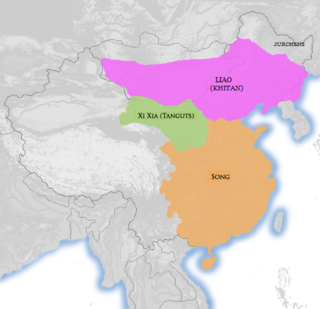
The Western Xia or the Xi Xia (Chinese: 西夏; pinyin: Xī Xià; Wade–Giles: Hsi1 Hsia4), officially the Great Xia (大夏; Dà Xià; Ta4 Hsia4), also known as the Tangut Empire, and known as Mi-nyak to the Tanguts and Tibetans, was a Tangut-led Buddhist imperial dynasty of China that existed from 1038 to 1227. At its peak, the dynasty ruled over modern-day northwestern China, including parts of Ningxia, Gansu, eastern Qinghai, northern Shaanxi, northeastern Xinjiang, and southwest Inner Mongolia, and southernmost Outer Mongolia, measuring about 800,000 square kilometres (310,000 square miles).
Jurchen is a term used to collectively describe a number of East Asian Tungusic-speaking people. They lived in northeastern China, also known as Manchuria, before the 18th century. The Jurchens were renamed Manchus in 1635 by Hong Taiji. Different Jurchen groups lived as hunter-gatherers, pastoralist semi-nomads, or sedentary agriculturists. Generally lacking a central authority, and having little communication with each other, many Jurchen groups fell under the influence of neighbouring dynasties, their chiefs paying tribute and holding nominal posts as effectively hereditary commanders of border guards.

Balhae or Jin, also rendered as Bohai, was a multiethnic kingdom established in 698 by Dae Joyeong and originally known as the Kingdom of Jin until 713 when its name was changed to Balhae. At its greatest extent it corresponded to what is today Northeast China, the northern half of the Korean Peninsula and the southeastern Russian Far East.

The Qara Khitai, or Kara Khitai, also known as the Western Liao, officially the Great Liao, was a dynastic regime based in Central Asia ruled by the Yelü clan of the Khitan people. Being a rump state of the Khitan-led Liao dynasty, Western Liao was culturally Sinicized to a large extent, especially among the elites consisting of Liao refugees.
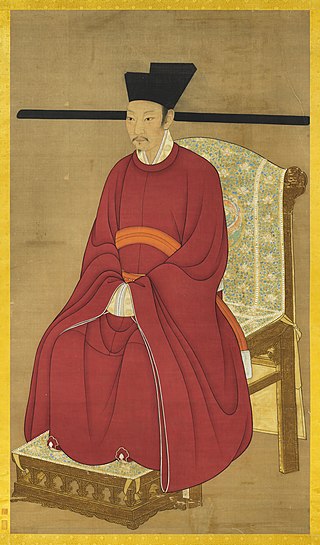
Emperor Qinzong of Song, personal name Zhao Huan, was the ninth emperor of the Song dynasty of China and the last emperor of the Northern Song dynasty.

Emperor Taizu of Jin, personal name Aguda, sinicised name Min, was the founder and first emperor of the Jurchen-led Jin dynasty of China. He was originally the chieftain of the Wanyan tribe, the most dominant among the Jurchen tribes which were subjects of the Khitan-led Liao dynasty. Starting in 1114, Aguda united the Jurchen tribes under his rule and rebelled against the Liao dynasty. A year later, he declared himself emperor and established the Jin dynasty. By the time of his death, the Jin dynasty had conquered most of the Liao dynasty's territories and emerged as a major power in northern China. In 1145, he was posthumously honoured with the temple name Taizu by his descendant Emperor Xizong.
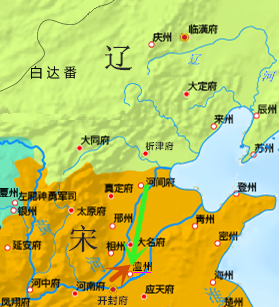
The Chanyuan Treaty was signed between the Northern Song dynasty and the Liao dynasty in 1005, and marked a pivotal point in Chinese history and in the relations between the two dynasties. The treaty laid the foundation for approximately a century of relative peace between the two major powers, which lasted until the Alliance Conducted at Sea was formed between the Northern Song dynasty and the Jin dynasty in the early 12th century. The diplomatic framework itself which set the peace would continue to be emulated throughout East Asia until the establishment of the Mongol Empire in the 13th century.
Emperor Tianzuo of Liao, personal name Yelü Yanxi, courtesy name Yanning, was the ninth and last emperor of the Khitan-led Liao dynasty of China. He succeeded his grandfather, Emperor Daozong, in 1101 and reigned until the fall of the Liao dynasty in 1125.
Yelü Dashi, courtesy name Zhongde (重德), also known by his temple name as the Emperor Dezong of Western Liao (西遼德宗), was the founder of the Western Liao dynasty. He initially ruled as king from 1124 to 1132, then as emperor and gurkhan from 1132 to 1143. He was also known in Muslim sources as Nūshī Taifū, Qushqin Taifū or Qushqīn, son of Baighū. A member of the imperial Yelü clan, he fled the Liao dynasty in northern China as it was on the verge of destruction by the Jurchen-led Jin dynasty and moved westward into Central Asia where he established a new empire.

Abaoji, posthumously known by his temple name as the Emperor Taizu of Liao, was a Khitan leader and the founding emperor of the Liao dynasty of China, ruling from 916 to 926. He had a sinicised name, Yelü Yi; some sources suggest that Abaoji's family name, Yelü, was adopted during his lifetime, although there is no consensus amongst historians on this point.

The Goryeo–Khitan War was a series of 10th- and 11th-century conflicts between the Goryeo dynasty of Korea and the Khitan-led Liao dynasty of China.

The Sixteen Prefectures of Yanyun comprise a historical region in northern China along the Great Wall in present-day Beijing, Tianjin, and part of northern Hebei and Shanxi. It was a site of constant military and political conflict between various dynasties from the end of the Tang dynasty until the establishment of the Yuan dynasty.
The Wanyan, alternatively rendered as Wanggiya, was a clan of the Heishui Mohe tribe living in the drainage region of the Heilong River during the time of the Khitan-led Liao dynasty. Of the Heishui Mohe, the clan was counted by the Liao dynasty among the "uncivilized Jurchens" (生女真), indicating that the clan was not subject to the direct rule of the Liao emperors. Those Heishui Mohe clans ruled by the Liao dynasty were referred to as "civilized Jurchens" (熟女真). The Wanyan clan later founded the Jin dynasty.
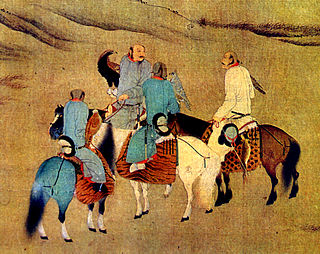
The Khitan people were a historical nomadic people from Northeast Asia who, from the 4th century, inhabited an area corresponding to parts of modern Mongolia, Northeast China and the Russian Far East.
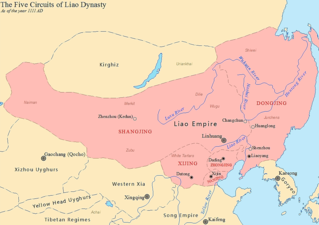
The Liao dynasty, also known as the Khitan Empire, officially the Great Liao, was an imperial dynasty of China that existed between 916 and 1125, ruled by the Yelü clan of the Khitan people. Founded around the time of the collapse of the Tang dynasty, at its greatest extent it ruled over Northeast China, the Mongolian Plateau, the northern part of the Korean Peninsula, southern portions of the Russian Far East, and the northern tip of the North China Plain.
The Northern Liao, officially the Great Liao, was a dynastic regime of China, distinct from the Liao dynasty, established by the Khitan Yelü clan in northern China. The state only existed for a short period of time between 1122 and 1123.

The Jin–Song Wars were a series of conflicts between the Jurchen-led Jin dynasty (1115–1234) and the Han-led Song dynasty (960–1279). In 1115, Jurchen tribes rebelled against their overlords, the Khitan-led Liao dynasty (916–1125), and declared the formation of the Jin. Allying with the Song against their common enemy the Liao dynasty, the Jin promised to cede to the Song the Sixteen Prefectures that had fallen under Liao control since 938. The Song agreed but the Jin's quick defeat of the Liao combined with Song military failures made the Jin reluctant to cede territory. After a series of negotiations that embittered both sides, the Jurchens attacked the Song in 1125, dispatching one army to Taiyuan and the other to Bianjing, the Song capital.

Nanjing was the name for modern Beijing during the Khitan-led Liao dynasty of China, during which it served as the empire's southern capital. To distinguish "Nanjing" from the modern city of Nanjing in Jiangsu, and Beijing Damingfu, the name for modern Daming County in Hebei Province during the Northern Song dynasty, Chinese historians sometimes refer to Liao-era Beijing as Liao Nanjing. The Liao acquired the city, then known as Youzhou, in the cession of the Sixteen Prefectures in 938 by the Later Jin, one of the five short-lived dynasties that ruled northern China following the end of the Tang dynasty. The city was officially renamed "Nanjing, Youdu Fu" (南京幽都府). In 1012, the city was renamed "Nanjing, Xijin Fu" (南京析津府). The city was also colloquially referred to at the time as "Yanjing". In 1122, the city was captured by the Jurchen-led Jin dynasty (1115–1234)—who officially renamed it "Yanjing", ending the use of "Nanjing" for what is today modern Beijing.

The administration of territory in dynastic China is the history of practices involved in governing the land from the Qin dynasty to the Qing dynasty (1644–1912).















